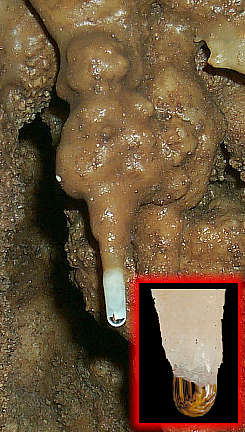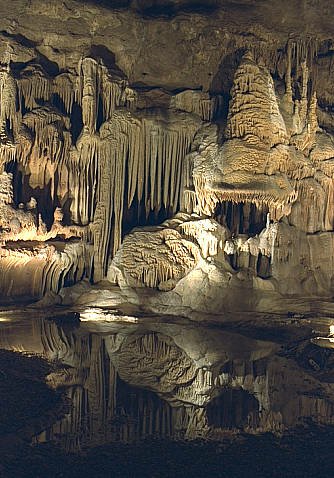 |
|
|
|
| Contact:
cavewithoutaname.com |
| Open daily, except for Thanksgiving and Christmas, from 9AM to 6PM in the summer and 10AM to 4:30PM in the winter. Special tours available by appointment. |
|
|
|
West
Cave (Bee Caves)) |
|
Inner
Space Cavern (Georgetown) |
| Wonder
World (San Marcos) |
| Longhorn
Cavern State Park (Burnet) |
| Natural
Bridge Caverns (New Braunfels) |
| Cascade
Caverns (Boerne) |
| Caverns
of Sonora (Sonora) |
| Kickapoo
Cavern State Park (Brackettville) |

|
|
|
Of language, in Faust, Goethe said, "Words are mere sound and smoke, dimming the heavenly light." Comprehend the meaning behind that quote, and you begin to understand the spirit behind The Cave Without A Name. The story surrounding the odd moniker dates back to 1938, when the owners of the property held a contest to name the cave, which would open to the public a year later. The winning entry came from young local who proclaimed the cavern, "too pretty to have a name." The $500 reward put the boy through college and the name has stuck ever since. Spend any amount of time at the site you begin to appreciate why words do not do justice to the majesty of the cave. Until it was opened to the public, the only way into the cave, was through a ten foot wide hole in the ground, which early farmers covered with a large boulder to prevent their livestock from plummeting to their death. From the opening, there is a 75-foot vertical drop which kept the cavern unexplored by anyone until the early 20th century. The first known persons to enter the cave were German immigrant farmers during the Prohibition period. The brewmasters removed the boulder and used a system of ropes and pulleys to descend to a small bluff where they made their whiskey. In the early 1930's, once Prohibition had ended and the Germans had left the area, a group of teenagers investigated the cavern and discovered a small hole, which led to a maze of tunnels and larger caverns. Finally, in 1939, The Cave Without A Name was opened to the public. What today's visitors are treated to is a breathtaking tour of the cave's six rooms and an extraordinary array of stalactite and stalagmite clusters, columns, delicate soda straws, intricate helictites and curtains, translucent rocks and unique flowstone formations. The countless unique features have been formed over thousands of years of water dissolving and cutting the limestone bedrock. The stalactites, which form from the roof down, and stalagmites, which grow upwards from the ground, as well as the other formations are continuing to grow today as water seeps through the surface of the Earth. The water collects calcite, which crystallizes and hardens as it drips and flows upon itself. Don�t expect to be able to perceive much of the change, however, as the growth occurs, on average, at the rate of only one cubic inch every hundred years. If you do tour the cave it is extremely important that you remember it is still living, as the constant dripping water attests. Do not touch any of the formations as the oil from your body destroys the calcite and prevent future growth. The Cave Without A Name also showcases a multitude of fossils embedded in the aged layers of limestone. One part of the cavern, directly below the original opening, is currently being investigated as it has become a hotbed of discovery. The bones, which are remains of animals that would fall through the hole, range from ancient cats to modern day pigs and sheep. Because of the age of the bones that have been found it is now known the cave has been around for at least 20,000 years. The sparkling and awe-inspiring artistry which Nature, through the centuries, has lavished upon this subterranean wonderland, is sure to be a thrill you will never forget. Using your imagination, the formations begin to take on familiar shapes, and though the tour guides have their own names and stories for many of the features, much of the wonder is finding your own visions and discoveries in the living monument. The tour ends with the sight and sound of a crystal clear underground river and waterfall flowing over the ancient formations. The river is so clear, that calcite can clearly be seen floating along its path. The tour, though fairly exhaustive, only covers a portion of The Cave Without A Name. To date, there are many unexplored tunnels and caverns still being investigated. In fact, as recently as March 4th, an entire new passageway was discovered, leading to the exploration of two previously unseen rooms. The cave is still 98 percent active and is naturally kept at a comfortable 66 degrees year round making it an ideal excursion in the sweltering summers or frigid winters. The Cave Without A Name, is difficult to find, and the last five miles of road that lead there are mostly unpaved, but this is what gives the site much of its charm. As Kristen Burton, a 28 year-old visitor from San Antonio attests, "I've been to a few caves here and in other states, but this one is special. It's not as commercial as a lot of other ones, and even though you have a guide, since there's not a lot of people it kind of feels like you're just finding out about it with them." The owners of The Cave are devoutly dedicated to its preservation, and except for a few lights and the entry stairs, you will find it remains almost entirely unblemished by the human hand. Unlike many of the other caverns of Hill Country, it is does not cater to tourists with dazzling colored lights and music shows, and the small number of visitors lend a homey atmosphere. The experience, instead, is geared toward focusing on the cave's own natural beauty, and just as its name suggests, it's a beauty too wondrous to fully grasp with mere words |
 |
 |
|
|
Formation referred to as"Bunches of Grapes" |
 |
|
|
|